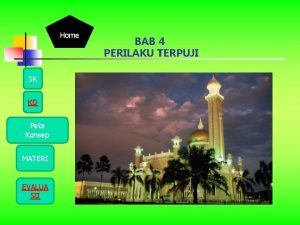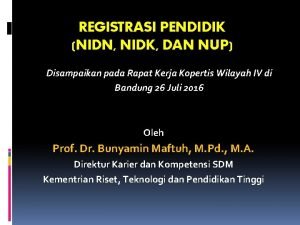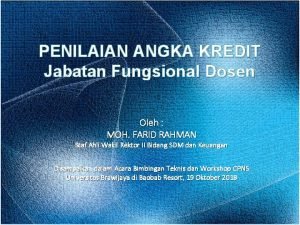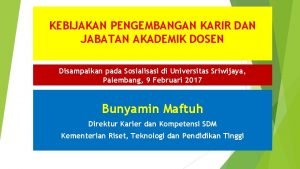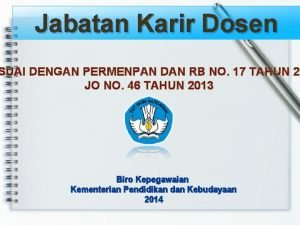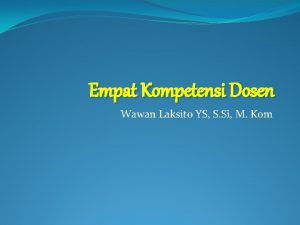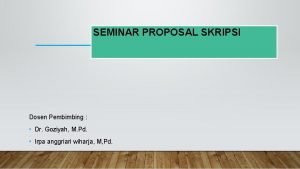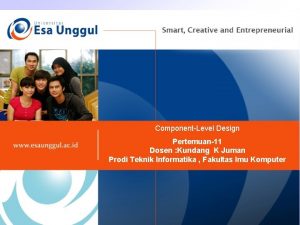System Engineering Pertemuan6 Dosen Kundang K Juman Teknik



















- Slides: 19

System Engineering Pertemuan-6 Dosen : Kundang K Juman Teknik Informatika & Fakultas Imu Komputer

Chapter 6 System Engineering - Computer-based system - System engineering process - “Business process” engineering - Product engineering (Source: Pressman, R. Software Engineering: A Practitioner’s Approach. Mc. Graw-Hill, 2005)

Computer-based System

Introduction • Software engineering occurs as a consequence of system engineering • System engineering may take on two different forms depending on the application domain – “Business process” engineering – conducted when the context of the work focuses on a business enterprise – Product engineering – conducted when the context of the work focuses on a product that is to be built • Both forms bring order to the development of computer-based systems • Both forms work to allocate a role for computer software and to establish the links that tie software to other elements of a computerbased system 4

System • System (Webster) – A set or arrangement of things so related as to form a unity or organic whole – A set of facts, principles, rules. etc. , … to show a logical plan linking the various parts – A method or plan of classification or arrangement – An established way of doing something such as a method or procedure 5

Computer-based System • Defined: A set or arrangement of elements that are organized to accomplish some predefined goal by processing information • The goal may be to support some business function or to develop a product that can be sold to generate business revenue • A computer-based system makes use of system elements • Elements constituting one system may represent one macro element of a still larger system • Example – A factory automation system may consist of a numerical control machine, robots, and data entry devices; each can be its own system – At the next lower hierarchical level, a manufacturing cell is its own computer-based system that may integrate other macro elements • The role of the system engineer is to define the elements of a specific computer -based system in the context of the overall hierarchy of systems 6

Computer-based System (continued) • A computer-based system makes use of the following four system elements that combine in a variety of ways to transform information – Software: computer programs, data structures, and related work products that serve to effect the logical method, procedure, or control that is required – Hardware: electronic devices that provide computing capability, interconnectivity devices that enable flow of data, and electromechanical devices that provide external functions – People: Users and operators of hardware and software – Database: A large, organized collection of information that is accessed via software and persists over time • The uses of these elements are described in the following: – Documentation: Descriptive information that portrays the use and operation of the system – Procedures: The steps that define the specific use of each system element or the procedural context in which the system resides 7

System Engineering Process

System Engineering Process • • • The system engineering process begins with a world view; the business or product domain is examined to ensure that the proper business or technology context can be established The world view is refined to focus on a specific domain of interest Within a specific domain, the need for targeted system elements is analyzed Finally, the analysis, design, and construction of a targeted system element are initiated At the world view level, a very broad context is established At the bottom level, detailed technical activities are conducted by the relevant engineering discipline (e. g. , software engineering) "Always design a thing by considering it in its next larger context – a chair in a room, a room in a house, a house in an environment, and environment in a city plan" 9

System Engineering Hierarchy World View Domain View Element View Component View 10

System Modeling (at each view level) • Defines the processes (e. g. , domain classes in OO terminology) that serve the needs of the view under consideration • Represents the behavior of the processes and the assumptions on which the behavior is based • Explicitly defines intra-level and inter-level input that form links between entities in the model • Represents all linkages (including output) that will enable the engineer to better understand the view • May result in models that call for one of the following – Completely automated solution – A semi-automated solution – A non-automated (i. e. , manual) approach 11

Factors to Consider when Constructing a Model • Assumptions – These reduce the number of possible variations, thus enabling a model to reflect the problem in a reasonable manner • Simplifications – These enable the model to be created in a timely manner • Limitations – These help to bound the maximum and minimum values of the system • Constraints – These guide the manner in which the model is created and the approach taken when the model is implemented • Preferences – These indicate the preferred solution for all data, functions, and behavior – They are driven by customer requirements Optimization of some of these factors may be mutually exclusive 12

System Modeling with UML • The Uniform Modeling Language (UML) provides diagrams for analysis and design at both the system and software levels • Examples – – Use case diagrams Activity diagrams Class diagrams State diagrams 13

“Business Process” Engineering

Business Process Engineering • “Business process” engineering defines architectures that will enable a business to use information effectively • It involves the specification of the appropriate computing architecture and the development of the software architecture for the organization's computing resources • Three different architectures must be analyzed and designed within the context of business objectives and goals – The data architecture provides a framework for the information needs of a business (e. g. , ERD) – The application architecture encompasses those elements of a system that transform objects within the data architecture for some business purpose – The technology infrastructure provides the foundation for the data and application architectures • It includes the hardware and software that are used to support the applications and data 15

Product Engineering

Product Engineering • Product engineering translates the customer's desire for a set of defined capabilities into a working product • It achieves this goal by establishing a product architecture and a support infrastructure – Product architecture components consist of people, hardware, software, and data – Support infrastructure includes the technology required to tie the components together and the information to support the components • Requirements engineering elicits the requirements from the customer and allocates function and behavior to each of the four components • System component engineering happens next as a set of concurrent activities that address each of the components separately – Each component takes a domain-specific view but maintains communication with the other domains – The actual activities of the engineering discipline takes on an element view • Analysis modeling allocates requirements into function, data, and behavior • Design modeling maps the analysis model into data/class, architectural, interface, and component design 17

Product Engineering Hierarchy Product Requirements Engineering Human Engineering Hardware Engineering Function Data/Class Design Software Engineering Database Engineering Data and Classes Architectural Design Interface Design Behavior Component Design System Component Engineering Analysis Modeling Design Modeling Construction 18

Summary • • Computer-based system System engineering process Business process engineering Product engineering 19
 Mahasiswa takut pada dosen
Mahasiswa takut pada dosen Evaluasi malin kundang
Evaluasi malin kundang Peta konsep diri sendiri
Peta konsep diri sendiri Apa yang kalian tentang
Apa yang kalian tentang Nomor urut pendidik
Nomor urut pendidik Jabfung dosen
Jabfung dosen Ir hasrul bakri
Ir hasrul bakri E-learning raden intan
E-learning raden intan Jabfung dosen
Jabfung dosen Tata kalimat lentur dan padu
Tata kalimat lentur dan padu Lektor 200 golongan
Lektor 200 golongan 4 kompetensi dosen
4 kompetensi dosen Tridharma dosen
Tridharma dosen Pangkat dan golongan dosen
Pangkat dan golongan dosen Seo fase 3
Seo fase 3 Contoh proposal hibah penelitian dosen pemula
Contoh proposal hibah penelitian dosen pemula Isdn dosen
Isdn dosen Perkenalan dosen
Perkenalan dosen Tugas dosen sebagai pengelola praktikum
Tugas dosen sebagai pengelola praktikum Puisi untuk dosen pembimbing
Puisi untuk dosen pembimbing


